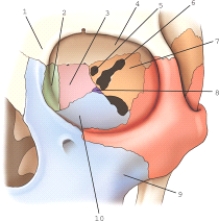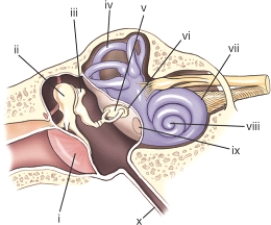A) temporal
B) ethmoid
C) palatine
D) sphenoid
F) All of the above
Correct Answer

verified
Correct Answer
verified
Multiple Choice
Where is the CR centered for a lateral projection of the facial bones?
A) Outer canthus
B) Acanthion
C) Midway between the glabella and the EAM
D) Zygoma, midway between the EAM and the outer canthus
F) B) and C)
Correct Answer

verified
Correct Answer
verified
Multiple Choice
Part 9 is part of which bone?

A) Zygomatic
B) Maxilla
C) Sphenoid
D) Ethmoid
F) A) and B)
Correct Answer

verified
Correct Answer
verified
Multiple Choice
The mastoid air cells communicate with the:
A) inner ear.
B) middle ear.
C) external ear.
D) base of the brain.
F) B) and D)
Correct Answer

verified
Correct Answer
verified
Multiple Choice
A radiograph of a parietoacanthial (Waters) projection reveals that the petrous ridges are superimposed over the lower 30% of the maxillary sinuses.What specific positioning error (if any) led to this radiographic finding?
A) Insufficient extension
B) Excessive extension
C) Excessive CR angulation
D) No error exists; accept the initial radiograph.
F) B) and D)
Correct Answer

verified
Correct Answer
verified
Multiple Choice
How much skull rotation (from a lateral position) is required to place the ramus parallel to the IR for the axiolateral oblique projection of the mandible?
A) None; the skull should be kept in a lateral position.
B) 30°
C) 45°
D) 53°
F) B) and D)
Correct Answer

verified
Correct Answer
verified
Multiple Choice
Which positioning line is parallel to the IR for the oblique inferosuperior (tangential) projection of the zygomatic arches?
A) Midsagittal plane
B) Infraorbitomeatal
C) Orbitomeatal
D) Glabelloalveolar
F) A) and B)
Correct Answer

verified
Correct Answer
verified
Multiple Choice
An average-shaped skull with a 47° angle between the petrous pyramids and the midsagittal plane is classified as:
A) mesocephalic.
B) brachycephalic.
C) dolichocephalic.
D) morphocephalic.
F) A) and D)
Correct Answer

verified
Correct Answer
verified
Multiple Choice
Along with the use of erect positions,what other technical factor is important to demonstrate air/fluid levels in paranasal sinuses?
A) Use of medium kV
B) Horizontal x-ray beam
C) Use of IR without a grid
D) Small focal spot
F) A) and D)
Correct Answer

verified
Correct Answer
verified
Multiple Choice
The part labeled i is the:

A) external acoustic meatus.
B) tegmen tympani.
C) auditory tube.
D) tympanic membrane.
F) All of the above
Correct Answer

verified
Correct Answer
verified
Multiple Choice
Match each radiographic appearance with the corresponding pathologic indication.(Use each selection only once.) -Excessive bone formation generally involving both the middle and inner ear
A) Otosclerosis
B) Acoustic neuroma
C) Cholesteatoma
D) Mastoiditis
F) C) and D)
Correct Answer

verified
Correct Answer
verified
Multiple Choice
Which of the following terms describes the junction of the two nasal bones?
A) Nasion
B) Acanthion
C) Glabella
D) Supraorbital groove
F) B) and C)
Correct Answer

verified
Correct Answer
verified
Multiple Choice
Which cranial bone contains the foramen ovale?
A) Sphenoid
B) Occipital
C) Ethmoid
D) Temporal
F) None of the above
Correct Answer

verified
Correct Answer
verified
Multiple Choice
Where are the ethmoid sinuses located within the ethmoid bone?
A) Perpendicular plate
B) Pterygoid processes
C) Cribriform plate
D) Lateral masses
F) A) and D)
Correct Answer

verified
Correct Answer
verified
Multiple Choice
The frontal bone articulates with ____ cranial bones.
A) four
B) six
C) two
D) five
F) B) and C)
Correct Answer

verified
Correct Answer
verified
Multiple Choice
A patient enters the ED with a possible fracture of the right zygomatic arch.Which of the following routines would best diagnose a possible fracture of this structure?
A) Submentovertex, parietoacanthial, and bilateral tangential superoinferior projections
B) Parietoacanthial, parieto-orbital, and lateral facial bone projections
C) Modified parietoacanthial, 15° PA Caldwell, and lateral facial bone projections
D) Submentovertex, bilateral oblique inferosuperior (tangential) , and AP axial projections
F) All of the above
Correct Answer

verified
Correct Answer
verified
Multiple Choice
Which of the following terms describes the anterior fontanel found in the adult skull?
A) Bregma
B) Pterion
C) Asterion
D) Lambda
F) B) and C)
Correct Answer

verified
Correct Answer
verified
Multiple Choice
Where does the CR exit for the optional PA axial projection of the mandible?
A) Junction of the lips
B) Nasion
C) Mentum
D) Acanthion
F) B) and D)
Correct Answer

verified
Correct Answer
verified
Multiple Choice
MATCHING Select the imaging modality that would best demonstrate the following pathologies. -Early detection of metastases
A) Nuclear medicine
B) MRI
C) CT
D) Ultrasound
E) Conventional radiography
G) B) and C)
Correct Answer

verified
Correct Answer
verified
Multiple Choice
How much difference is there between the OML and IOML positioning lines?
A) 7° to 8°
B) 8° to 9°
C) 10° to 11°
D) 5° to 6°
F) All of the above
Correct Answer

verified
Correct Answer
verified
Showing 61 - 80 of 181
Related Exams